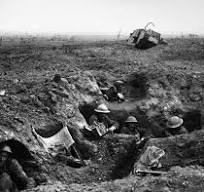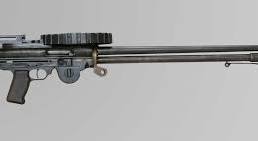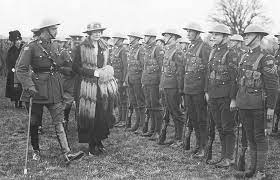I.W.T.’s W.W.1 STORIES by BARNEY MOORHOUSE
Researching the Bancroft Times’ archives, seeking material for my TIMES TRAVELLER column, I came upon a series of articles penned in 1962 by an author going by the moniker I.W.T. Unlike to-day, at that time, very few newspaper articles were accompanied by the writer’s name. Presumeably employees of the paper wrote them with no credit whatsoever. I.W.T. evidently grew up in the Bancroft area and at a mature stage in his life was putting pen to paper recording life experiences as he remembered them. Most of my attempts to identify such an author prove futile; this being the exception.
Marguerite McColl was a friend who lived for a century, mostly in Bancroft. She taught in the nearby Hamlet of Coe Hill “around 1931” and Wooler before marrying Pete in 1934. (I wonder if she taught the poet Al Purdy who was from Wooler?) Her ancestors were among the first to settle Bancroft and Marguerite had a wonderful memory. While writing about the origins of settlement in the area Marguerite proved a wonderful resource. In fact, during these meetings she gave me some photocopies of articles written by, I believe, her uncle, Warren Davy, in 1962. He signed them I.W.T. I Was There.
To my pleasant shock and surprise I gleaned through my personal archives and found the files within minutes. What follows is a compilation of columns written by I.W.T. for The Bancroft Times in 1962, all relating to his WW1 experiences.
DEAN and ANDREW COLLINS
On the honour roll in Bancroft among the names of those who gave their lives for their country in the First World War are those of Dean and Arnold Collins. To anyone not familiar with the Bancroft of fifty years ago (1912) the names will mean very little.
The first (train) station agent in Bancroft was John Collins. When the family arrived in the village there were two sons and a daughter. Two more daughters were born in Bancroft. As the two boys were about my age, Dean about a year older and Arnold a year younger, and we were near neighbours, we became good friends.
Dean and I were seat-mates in school during our last year there. We swam together, played baseball and they kindly lent me books of which they had a great many. At school most of the other pupils were a trifle envious of them. They were always better dressed than the majority. They were the only boys who wore long overcoats to school. For this one young lady named them “the Preachers.” In cold weather when they brought their lunches each of them invariably had a delicious-looking red apple which caused the mouths of the other pupils to water.
Dean and I passed the entrance together after which he went away to High School in Stirling. Two years later Arnold passed and he and I went to Trenton High School to which Dean transferred. That was in 1909. (The year Marguerite was born.) I took only one year there and later went to Stirling while they completed their High School education at Trenton. Several years later their family moved away from Bancroft.

I didn’t hear of them again until 1916. At that time I was in Ypres in Belgium. I had received a letter from my sister telling me that both Dean and Arnold were in France or Belgium with the P.P.C.L.I. (Princess Patricia’s Canadian Light Infantry). One day I heard someone mention that a detachment from that regiment was spending the day in the old Cavalry Barracks before going into the line that night. As we were having an unusually quiet day I took the time off and went around there expecting to make inquiries but one of the first men I met was Dean.
He seemed very glad to see me and we spent an enjoyable half hour talking about old times in Bancroft. He informed me that Arnold had gone back to England to train for a commission. He also told me that on a previous tour of duty in the front line he had gone over to the enemy line in a night raid. He had been the bayonet man in his group and he didn’t like that part of it very much so he applied for a transfer to the Lewis Gun section.

In the summer of 1917 I heard that the P.P.C.L.I. were resting at Mont St. Eloy. As I had just come out of Vimy and was staying a few days a couple miles from there, I decided to pay him another visit. I got half a day off and having borrowed a bicycle from the Quartermaster I was soon there. I had no difficulty locating him. He was head of a Lewis Machine Gun crew and seemed to be in good spirits. He told me that Arnold was then a lieutenant but was attached to another unit and he hadn’t seen him since his return to France.
That was the last I ever saw him nor did I hear anything more of them until I returned to Bancroft in July 1919. There I learned that both of them had been killed in those last hectic days of 1918. They were two very fine boys.
HIDDEN TREASURE
In the spring of 1917 our field artillery battery was stationed in the village of Ablain Ste. Nazaire in north-western France. To the east lay the northern end of Vimy Ridge topped by that small elevation destined to become notoriously known as “The Pimple.” The area around the village had been the scene of heavy fighting and the village was little more than a heap of rubble. The bottom of our gun-pit was a beautiful tiled floor which must, at one time, have been the kitchen of a very substantial home.
One morning two visitors entered the village, an old Frenchman and his grand-daughter, former residents. They had obtained permission from headquarters to enter the village for the purpose of recovering a treasure that the old man had buried in his garden before the family’s hurried departure in the face of the approaching enemy.
A small party was detailed to render any possible assistance.
It took only a few moments to discover that both visitors were in difficulty. They couldn’t pick out any degree of accuracy the location of their former home. After several hours of stumbling over debris and among shell holes they decided to give up – physically tired and disappointed. The old gentleman thanked us, said “Goodbye!” and with the girl wiping tears from her cheeks they started slowly down the road, a pathetic-looking pair.
I have often wondered if they ever recovered the treasure or was it lost for all time?
THE NEXT TREAURE
It was April 1917, two days after the start of the Battle of Vimy Ridge that our field artillery finally completed the trek over the ridge and dropped down into the valley that separates the town of Vimy from the ridge. Weary from the rough going we billeted down in a loft that three days before had been occupied by enemy soldiers.
Early next morning we set about digging gun-pits in a garden. It was easy digging and soon we hit something solid. At first we thought it was a rock but further investigation revealed an earthenware jar about a foot high and six inches in diameter. Whatever was inside rattled. Removing the cork, we found real gold coins. Various sizes! We saw ten-franc pieces, twenty francs, some one hundred francs. The lower half of the jar seemed to be filled with five-franc pieces.
The Commanding Officer replaced the cork and carried the jar away. That was the last I saw of the treasure. During the hectic and busy weeks that followed I almost forgot about the treasure. As the finder was not a member of our gun-crew I never learned of the value of the find (it must have been considerable) nor what became of it but of this I am sure, that the man who hastily buried his life’s savings before fleeing from the village never saw any of it.

